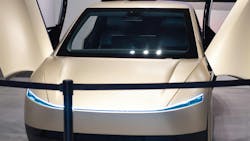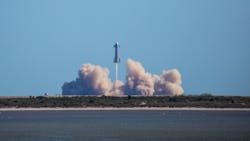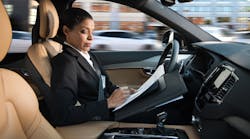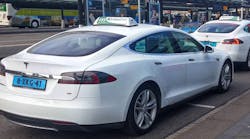So...It’s Time for a $20,800/year FCC License to Teleoperate a Robot
What you’ll learn:
- Tesla full self-driving is still unable to operate unassisted, though the Cybertaxi is imminent.
- Tesla’s Optimus robot is humanoid, among many superior topology choices, likely to facilitate teleoperation.
- SpaceX’s low-latency, high-bandwidth Starlink enables worldwide teleoperation of their robots and AI may be a cover story.
Optimus seems cute
When it serves up party drinks
But who's really served?
Mankind has always fascinated itself with the idea of building a machine that could perform its dull and dangerous tasks, leaving humanity to engage in leisure, the arts, and intellectual pursuits, while the less ambitious are perfectly content throwing darts and hugging a bar stool.
Automation, since the days of the punch-card-programmed Jacquard loom, promised repeatability and productivity, with machines able to outperform their human counterparts in terms of speed and precision.
Oligarchs fantasized about eliminating a pesky workforce with their trade unions, sick leaves, demands for higher wages, and unpredictable tenure and attendance. This also would remove the associated OSHA regulations, immigration visas, work permits, absences, whistle-blowing, and, worst of all, employer-paid taxes that included Social Security, Medicare, unemployment insurance, and workmen’s compensation premiums. Machines need none of these and the money saved theoretically goes straight to profits.
With this recent new-dawn of generative Artificial Intelligence (“AI”), a promised form of automation that replaces knowledge workers, the focus of media has been on the threat AI poses to the office-class of worker bees, with little to no coverage of the threat to the “you gotta be there to do it” jobs. This is also now changing.
Can’t Spell Autopilot Without AI
In October 2015, Tesla launched its “Autopilot” for use in 60,000 Model S and X cars. Within about a year, the fleet would amass 300 million miles of operating data—and it would claim its first fatality within seven months. A year later, Musk released a video where the car was claimed to be driving itself without operator intervention, with an admission emerging seven years later that the video was staged on Musk’s directive.
In April of 2019, Musk claimed to have a million cars running Autopilot and promised an OTA update of Autopilot that would enable those vehicles to act as “Robotaxis” within a year. Each car would generate $30,000 a year of taxi revenue for their owners. It’s still crickets on that one...
In October 2020, Tesla launched Full Self-Driving (Beta), with Musk stating he was extremely confident of achieving full autonomy and releasing it to the Tesla customer base the following year [insert toe tapping here]. Full autonomy has yet to be demonstrated, as of this writing. Reuters reported both the Department of Justice and the Securities and Exchange Commission are believed to be investigating Tesla’s claims over its revenue-generating driving automation tech.
“For almost a decade now, Tesla and its CEO Elon Musk have repeatedly promised that its automated-driving assists like Autopilot and “Full-Self Driving (FSD) Beta” are safer than humans—and on the verge of obsoleting us entirely.—The Drive, May 8, 2024
A little over a month ago at Tesla’s “We, Robot” event, Musk announced the “Cybertaxi,” a two-seat fully autonomous vehicle without a steering wheel or pedals. He claimed 15 rattle-can-painted cars were running at the event without passengers in a driving loop on the Warner Brothers closed course for all to see.
Despite FSD yet to demonstrate full autonomy, this new allegedly AI-robot-chauffeured electro-chariot was Musk’s clearly weapons-grade BSing in an effort to pump the company’s stock price (it worked). The FSD software in the latest Teslas can’t do this, despite owners dumping tens of thousands of dollars apiece into the capability for their own cars—most likely because the Cybertaxi chauffeur isn’t software, but as I’ve suspected, it’s teleoperated. This was reported in Gizmodo less than a week ago.
Aye Robot
During the same “We, Robot” event this past October, Musk (Tesla) also announced the Optimus human-like robot. The robot is strangely proportioned to the human form and includes all of our major joints. As any automation engineer can attest, many robot topologies are much better suited to industrial tasks. For example, a fixed-base delta robot is extremely fast at assembly line pick-and-place tasks.
Tesla’s creepy deployment at the We, Robot event, however, was not bolting quarter panels onto cars or using a power screwdriver to assemble electronics. Rather, it featured go-go dancing, marching as a foreshadowing of its grim anti-civilians application by his alleged despotic pals, and serving drinks at a bar. These were very clearly teleoperated, with someone remotely controlling them with a VR headset and joint mapping/tracking transducers. Such operation, like the remote chauffeuring of the Cybertaxi, requires low latency, high bandwidth, and data links.
Starlink, Starship, and the Stellar Fantasy of Mars
It’s no secret that Musk is deploying Starlink LEO (low Earth orbit) satellites as quickly as he can launch Falcon 9 rockets from both the Florida and California launch complexes. It’s simply not fast enough to deploy and maintain such a large constellation of up to 34,400 satellites, which brought about Starship. Each launch will burn about 1.8M pounds of methane propellant, with three launches expected per day to service Starlink.
Musk’s aspirations clearly go beyond the internet satellite service provided by the likes of Hughes, to where he’s providing contract services to the military. For example, the low-latency data links are being used to control drones, weapons, and surveillance gear. He’s also been rumored to deny Starlink service on behalf of questionable interests.
The public outrage of burning almost 6M pounds of methane, generating almost 100 tons of CO2, per day has been quelled by Musk by weaving a Mars colonization fantasy in the public mind by using the very same, fast-turnaround, satellite-launcher rocket—the Starship. The joke in all this is that the “stars” are artificial—the 34,400 shooting stars of a Starlink constellation.
A Trillionaire’s RC Toys
The light bulb should have lit up by this point on what Musk is likely up to. The military is already operating teleoperated robot drones in the war in Ukraine, via Starlink. Musk has brashly shown us working, teleoperated robots in the form of Cybertaxi and Optimus. With worldwide coverage using Starlink’s bidirectional, low-latency, satellite links, a teleoperator anywhere can operate a Cybertaxi or Optimus robot anywhere.
What this means is that any physical task performed by a human being, including skilled trades, now falls to the lowest common denominator of cost by employing operators in extremely low cost-of-living parts of the world.
While it can be argued that this uplifts poverty, I’d argue that poverty, like energy, is conserved and that the workers who were a total pain in the butt to Musk in the Bay Area during peak COVID will be laid off and replaced by a legion of Optimus robots. Uber and Lyft drivers will be replaced by teleoperators willing to work for $10/day. We’ll see an avalanche of unprecedented economic destruction, proliferated by people of questionable patriotism.
A billionaire’s money-hoarding mental illness is unbounded, and even these low-wage workers will eventually be replaced by AI. Eventually, that, in my opinion, is still a few decades away, because reasoning and problem-solving are still well out of reach of GenAI as demonstrated by Tesla’s inability to show full self-driving in its cars to date. Meanwhile, teleoperation is being used to create datasets to train GenAI.
Time for an Annual FCC Operating License for ’Bots
While this is my own opinion that follows, and not that of Endeavor Business Media or Electronic Design, I, for one, might welcome our worker-displacing Cybertaxis and Optimoose, if they contributed to the common good of humanity and not end up feeding the Lex Luthorian ambitions of the few to destroy the good in the world.
Though it’s obvious that robot chauffeurs, trades, and factory workers will create massive levels of unemployment in physical jobs, I think public policy and legislation can trade off unemployment for non-employment if done with intelligent foresight. Contact your government legislators to enact a licensing system, most suitably administered by the FCC in the case of American interests, where an annual fee (like $10/hr/shift = $20,800?) is payable to operate a telerobot.
By extension, the replacement of the teleoperator, or non-use of a teleoperator from the outset, using AI should incur an additional fee that zeroes out any benefit in displacing a human teleoperator or human. It’s a complicated formula that requires economists, not EEs, to formulate to the benefit of all of us.
These funds would be set aside to top off Social Security, and then for a universal basic income program that’s equally distributed to all citizens. It would in turn fuel a consumption economy, perhaps even subsidizing a 30-hour workweek, if even that much. Without such soft economic landings and human benefits, the destruction of disposable income will likely lead to the total collapse of society as we know it. The only safe haven for the oligarchs will be… a Mars colony that society ironically will have paid to establish.
All for now,
-AndyT
Andy's Nonlinearities blog arrives the first and third Monday of every month. To make sure you don't miss the latest edition, new articles, or breaking news coverage, please subscribe to our Electronic Design Today newsletter.
p.s. I decided to share this little experiment with you - I had an AI scan this blog and generate the following quiz. It did OK, though I added the word "local" to one of the possible answers. Just an experiment, not something worth doing more than this one time, imo.
Take it if you want, no registration needed...
About the Author
Andy Turudic
Technology Editor, Electronic Design
Andy Turudic is a Technology Editor for Electronic Design Magazine, primarily covering Analog and Mixed-Signal circuits and devices. He holds a Bachelor's in EE from the University of Windsor (Ontario Canada) and has been involved in electronics, semiconductors, and gearhead stuff, for a bit over a half century.
"AndyT" brings his multidisciplinary engineering experience from companies that include National Semiconductor (now Texas Instruments), Altera (Intel), Agere, Zarlink, TriQuint,(now Qorvo), SW Bell (managing a research team at Bellcore, Bell Labs and Rockwell Science Center), Bell-Northern Research, and Northern Telecom and brings publisher employment experience as a paperboy for The Oshawa Times.
After hours, when he's not working on the latest invention to add to his portfolio of 16 issued US patents, he's lending advice and experience to the electric vehicle conversion community from his mountain lair in the Pacific Northwet[sic].
AndyT's engineering blog, "Nonlinearities," publishes the 1st and 3rd monday of each month. Andy's OpEd may appear at other times, with fair warning given by the Vu meter pic.






